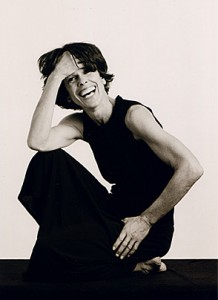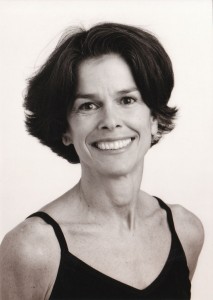If you missed Janet Lott’s great workshop for tango dancers, Dancing with Gravity, here is an overview that might be helpful. You can take her next workshop coming up, April 28, 2012.
Janet has an MFA from the California Institute of Art, has directed her own dance troupe, and is a skilled practitioner of Alexander Technique. Janet focused on issues of balance and avoiding injury by  understanding what she calls tensegrity of the body.
understanding what she calls tensegrity of the body.
To help us understand tensegrity and the body we inhabit (one hopes), Janet held up a small model that resembled Buckminster Fuller’s geodesic dome. It was a simple, symbolic model of the body’s muscle anatomy. The bones (pencil-sized wooden sticks) and muscles (elastic bands), surrounded by air, touched only where they inserted, at joints, but never lay on top of each other. They rested, suspended on their own ability or tensegrity.
Janet explained that we have red and white muscles. Athletes who train know these as slow-twitch (white) and fast-twitch (white) muscles. White muscle is what endurance athletes and marathoners use. Red muscle, which fatigues faster than the white, is what short-distance runners, who quickly become anaerobic (exhaust their air) use.
From Janet who teaches tango and the Alexander technique:
Regarding what I am calling red and white muscles: Think of a chicken’s dark and white meat. Dark is the legs and thighs, chickens can walk around all day.
Those are the deep muscles that support our bones. The white is the wings and breast. Chickens can fly in spurts but not very far or for very long. Those are our larger muscles on the outside (generally) of our bodies that we use for larger movements. These muscle groups can be trained to take over the work of the other, but, generally we desire to enhance the strength of the red muscles because they have greater strength in the long run. We use all these groups all day. What gets us in trouble (one thing) is using the white muscles to support the bones instead of the letting the red muscles do that. Using the white muscles to do the work of the red causes the red to loose tone and, therefore, strength. The good news is that that is reversible. Over use of white muscles is tension and lack of flexibility. We are not able to move smoothly and easily.
For the most part in tango, we use white muscle. Although, it does look like some of those fancy stage tango moves require fast-twitch muscle. That’s a discussion for another time.
Janet had us lie on the floor and do almost nothing but lie there with our knees bent. We were letting gravity do the work. I had just read that this position is great for that much-touted muscle called the psoas, which connects our spines to our femurs. It’s big and deep inside of us. Lying down on our backs, we give the psoas a chance to rest and recharge.
Next we played with our range of motion. We broke into partners, one person lying still (corpse-pose-like). The other person started at the person’s head, gently rolling that bowling ball on its neck stem joints, with no help from the head’s owner. She then moved to the arms and legs, doing the same rotation of joints. My partner had a hard time letting go and letting me do the work. For me, this exercise in surrender was very relaxing although my partner never even approached my range-of-motion limit. In tango, we don’t need a wide range of motion for most limbs/joints. The exception is the spinal twist as we call it in yoga. Spinal twist is what you do when you allow your upper body to rotate in opposition to your lower body, as we do in ochos, forward and back. It is a good idea to get agile and smooth at this motion. You will use it numerous times. Imagine that your spine is the axis we allude to. Come on, let’s twist again, like we did last summer . . .
Janet quizzed us on where we think the skull connects to our bodies. We all failed. Let Janet tell you where those important coordinates are in her next workshop. She asked us to touch where our hips (that ball and socket of a joint) originate. Some got it wrong, but I know my hips well from years of yoga hip openers. In tango, we say we move from the hips, although you will repeatedly hear that you shouldn’t sway your hips, as in salsa or other Latin dances, say. This is true, you can check with Janet on this. I would add that the whole body is engaged in tango walking. I fall back on my panther example: That feline may move just a paw or talon at a time, but watch the way her muscles ripple and support that one tiny move even. Total engagement whether it’s white or red muscle, fast or slow-twitch, from the breath to the toes to the crown of your head, all is alive.
 Once we knew where our heads connected to our bodies and our hips originated, Janet had us do a lot dancing to music, some of it alone, some in partners. She studied the way we moved and came around helping us to optimize our dance. People in the class who announced that they had balance concerns were quite pleased by the end of the class.
Once we knew where our heads connected to our bodies and our hips originated, Janet had us do a lot dancing to music, some of it alone, some in partners. She studied the way we moved and came around helping us to optimize our dance. People in the class who announced that they had balance concerns were quite pleased by the end of the class.
I highly recommend Janet’s workshop, especially for beginning tango dancers. Contact Janet for more info or to reserve 415.272.4811 janet@janetlott.com.
What Felipe Martinez, one of the Bay Area’s most respected tango teachers, says of Janet Lott: In my experience, the Alexander Technique is very effective for cultivating body/self awareness and release of tension, both essential for tango. Janet Lott knows what she is doing.
